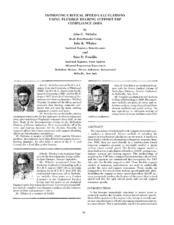| dc.contributor.other | Turbomachinery Symposium (15th : 1986) | |
| dc.creator | Nicholas, John C. | |
| dc.creator | Whalen, John K. | |
| dc.creator | Franklin, Sean D. | |
| dc.date.accessioned | 2017-10-05T14:31:54Z | |
| dc.date.available | 2017-10-05T14:31:54Z | |
| dc.date.issued | 1986 | |
| dc.identifier.uri | https://hdl.handle.net/1969.1/163637 | |
| dc.description | Lecture | en |
| dc.description | Pg. 69-78 | en |
| dc.description.abstract | The importance of including flexible supports in rotordynamic analyses is discussed. Various methods of including the support in rotordynamic calculations are reviewed. A method is described in which actual compliance frequency response function, FRF, data are used directly in a rotordynamic forced response computer program to accurately predict a steam turbine rotor's critical speed. The flexible support model is described as two single degree of freedom, SDOF, spring-mass-damper systems per bearing support. The methodology of acquiring the FRF data via impact hammer testing is described, and the equations are summarized that incorporate the FRF data into the flexible support model. Three flexible support models of increasing sophistication are used to analytically predict the rotor and support resonances. These results are compared to the actual steam turbine speed-amplitude plots. Modelling the support as many speed dependent SDOF systems accurately predicts the location of the rotor's first critical speed and also the split critical peaks and several support resonance speeds. | en |
| dc.format.medium | Electronic | en |
| dc.format.mimetype | application/pdf | |
| dc.language.iso | en | |
| dc.publisher | Texas A&M University. Turbomachinery Laboratories | |
| dc.relation.ispartof | Proceedings of the 15th Turbomachinery Symposium | en |
| dc.subject.lcsh | Turbomachines | en |
| dc.title | Improving Critical Speed Calculations Using Flexible Bearing Support FRF Compliance Data. | en |
| dc.type.genre | Presentation | en |
| dc.type.material | Text | en |
| dc.identifier.doi | https://doi.org/10.21423/R1B09S | |


